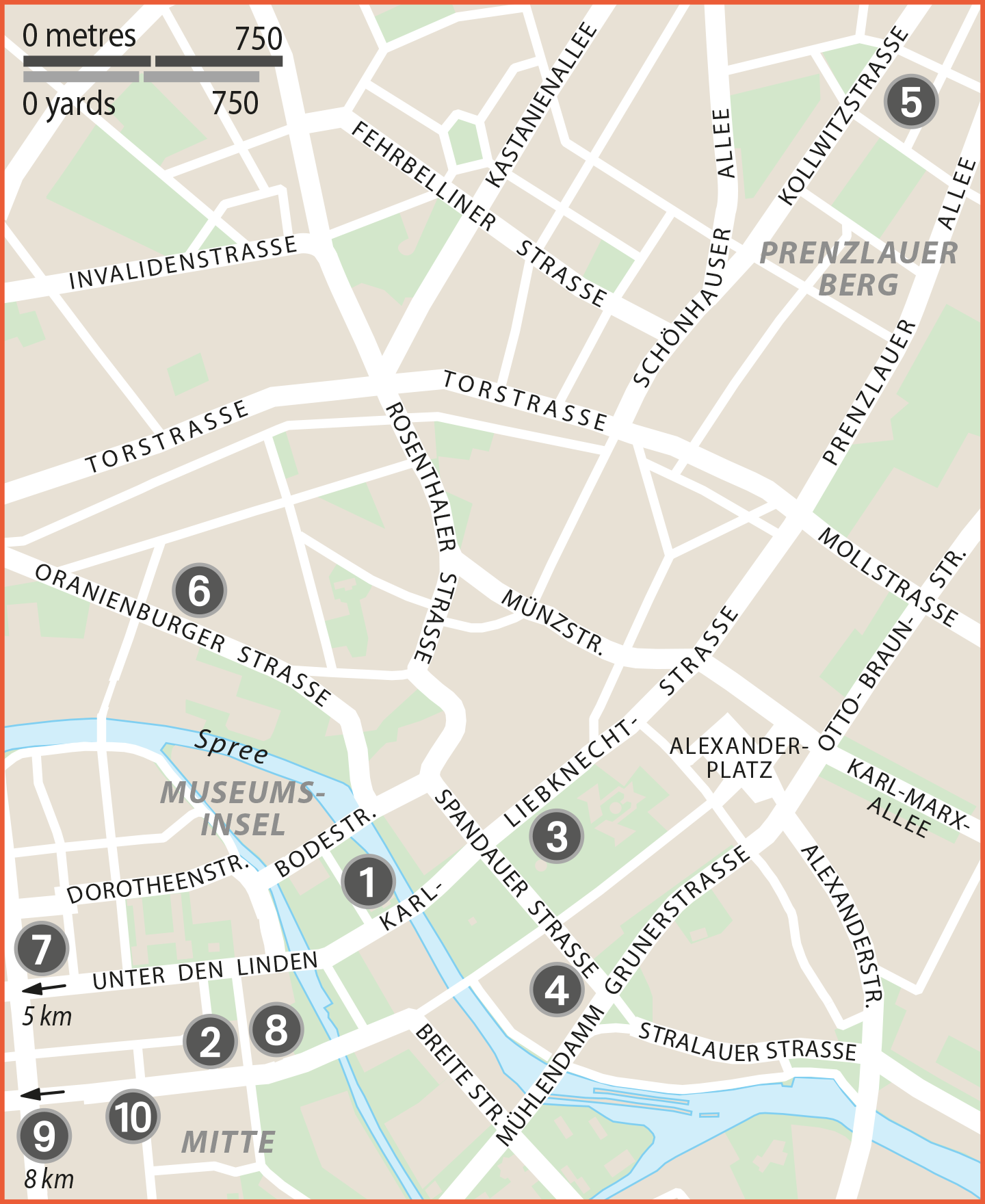CHURCHES AND SYNAGOGUES

1.Berliner Dom
 Am Lustgarten • 030 20 26 91 19 • Apr–Sep: 9am– 8pm Mon–Sat, noon–8pm Sun; Oct–Mar: 9am–7pm Mon–Sat, noon–7pm Sun • Admission charge • www.berlinerdom.de
Am Lustgarten • 030 20 26 91 19 • Apr–Sep: 9am– 8pm Mon–Sat, noon–8pm Sun; Oct–Mar: 9am–7pm Mon–Sat, noon–7pm Sun • Admission charge • www.berlinerdom.de Berlin Cathedral, the largest and most lavish church in the city, was reopened in 1993, after almost 40 years of restoration work. Designed by Julius Raschdorf between 1894 and 1905, the building reflects the empire’s aspirations to power. In particular, the black marble imperial stairs are a sign of the proximity of the Hohenzollern residence opposite the cathedral. Members of this powerful ruling dynasty are buried in the crypt. The main nave, topped by an 85-m (279-ft) high dome, is remarkable. The church is dominated by a splendid 20th-century Neo-Baroque pulpit and the giant Sauer organ.

Baroque-style exterior, Berliner Dom
2.St Hedwigskathedrale
 Bebelplatz • 10am–5pm Mon–Sat, 1–5pm Sun • wwww.hedwigs-kathedrale.de
Bebelplatz • 10am–5pm Mon–Sat, 1–5pm Sun • wwww.hedwigs-kathedrale.de Berlin’s largest Catholic church was built by Frederick the Great in 1747–73 after his conquest of Silesia (for further details see St Hedwigskathedrale).
3.Marienkirche
Work started in 1270 on the Church of St Mary, which nestles at the foot of the Fernsehturm. Gothic and Baroque in style, it has an impressive Neo-Gothic tower, added in 1790 by Carl Gotthard Langhans. The font (1437) and the fresco Dance of the Dead (1485) are among the church’s oldest treasures. The richly ornamented Baroque pulpit was made by Andreas Schlüter in 1703 (for further details see Marienkirche).
4.Nikolaikirche
 Nikolaikirchplatz • 10am–6pm daily • Admission charge • wwww.en.stadtmuseum.de
Nikolaikirchplatz • 10am–6pm daily • Admission charge • wwww.en.stadtmuseum.de Berlin’s oldest sacred building, this was built in 1230 in the Nikolaiviertel quarter. The present church dates to around 1300. It is particularly famous for the portal on the west wall of the main nave, created by Andreas Schlüter. It is adorned with a gilded relief depicting a goldsmith and his wife. The church was rebuilt in 1987 and completely restored in 2009. It is now a museum exploring the history of the church and the surrounding area. Regular events and concerts are held here.
5.Synagoge Rykestraße
Berlin’s largest synagogue, this is one of the few Jewish places of worship in Germany to have survived Kristallnacht. It looks the same today as when it was originally built over 100 years ago (for further details see Synagoge Rykestraße).
6.Neue Synagoge
Once Berlin’s largest synagogue, this was built originally in 1859–66. It was demolished in World War II and partially reconstructed in 1988–95. Its magnificent, ornate dome is visible from afar (for further details see Neue Synagoge).

Beautiful dome of the Neue Synagoge
7.Kaiser-Wilhelm-Gedächtnis-Kirche
A landmark in West Berlin, the Kaiser Wilhelm Memorial Church successfully combines modern architecture with the ruins of the church tower (for further details see Kaiser-Wilhelm-Gedächtnis-Kirche).

Kaiser-Wilhelm-Gedächtnis-Kirche
8.Friedrichswerdersche Kirche
 Werderscher Markt • 10am–6pm daily • wwww.smb.museum
Werderscher Markt • 10am–6pm daily • wwww.smb.museum This Neo-Gothic church was built by Karl Friedrich Schinkel in 1824–30. Originally it was meant to serve the German and French communities of the Friedrichswerder district.
9.Christi-Auferstehungs-Kathedrale
 Hohenzollerndamm 166 • Open only during service 10am & 6pm Sat, 10am Sun
Hohenzollerndamm 166 • Open only during service 10am & 6pm Sat, 10am Sun Berlin’s largest Russian-Orthodox church, the Church of Christ’s Ascension is known for its green onion domes. Services are held in Russian, following Orthodox rituals.
10.Französischer Dom
 Gendarmenmarkt 5 • Noon–5pm Tue–Sun • franzoesische-friedrichstadtkirche.de
Gendarmenmarkt 5 • Noon–5pm Tue–Sun • franzoesische-friedrichstadtkirche.de At 66 m (216 ft) high, this domed Baroque tower, which dates back to between 1780 and 1789, is a magnificent ornamental addition to the Friedrichstadtkirche serving Berlin’s Huguenot community (for further details see Gendarmenmarkt).


